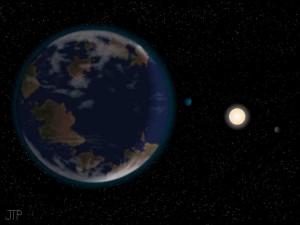News this week included a report that planet-searchers have found a “super-Earth” orbiting a star just 42 light years from “regular “(but still impressive) Earth.
[Given that distance, Bob Murphy, a colleague and friend, has suggested that we name the planet “Douglas Adams”, author of Hitchhiker’s Guide to the Galaxy, in which that number has keen significance as the “Answer to the Ultimate Question of Life, the Universe, and Everything”. I like it!]DA (as I will call it here) was discovered upon a reexamination of data that had already been picked over. The reanalysis used new techniques, able to pull a very weak signal out of significant noise, using data from the High Accuracy Radial velocity Planet Searcher, or HARPS, a terrestrial-based telescope in Chile. This makes six planets found to be orbiting the star, with DA located in the so-called “habitable zone”, where conditions may be suitable for life as we know it.
There are still a great many “ifs” and unknowns, but it does show that possibilities do exist Out There for life.
It also shows that one should always be open to reexamining “old” data to glean new information.
Questions: Do you ever revisit an analysis (of any kind) to see signals you may be able to pull out that were otherwise hidden? What do you think might cause such a signal to be hidden in the first place? Might you acknowledge that the hiding was intentional, albeit unconscious? How can you ensure that such signals don’t get lost in the noise forever?

